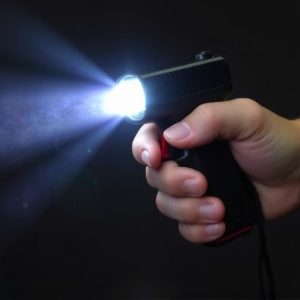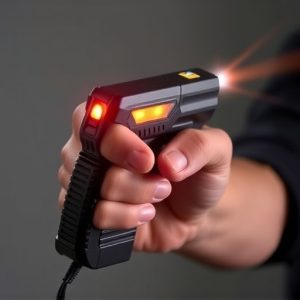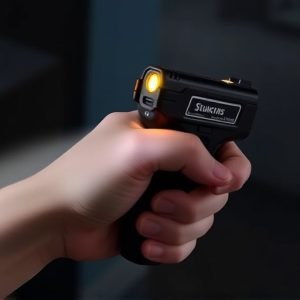Ergonomic Stun Gun Designs: Comfort Meets Effectiveness
Stun guns, or electroshock weapons, are non-lethal self-defense tools that temporarily incapacitate…….
Stun guns, or electroshock weapons, are non-lethal self-defense tools that temporarily incapacitate attackers using electric current. They function by delivering a strong electric pulse through two metal probes, disrupting the attacker's neuromuscular system. Comfortable grip design is crucial for effective deployment, with ergonomic features like balanced weight distribution and textured surfaces preventing drops. Modern stun guns have safety mechanisms and compact designs, but their use is heavily regulated due to potential misuse concerns. Future advancements aim to enhance comfort, effectiveness, and safety, making them accessible to a broader range of users while maintaining reliability. Understanding how stun guns work is key to appreciating these design considerations and ensuring user control during activation.
“Discover the evolution of self-defense with comfortable grip stun gun designs. This comprehensive guide explores the inner workings of these non-lethal tools, from the science behind their incapacitating effect (how does a stun gun work?) to the ergonomic factors ensuring a secure and comfortable hold. We delve into legal considerations, safety precautions, and future trends, providing insights for informed decisions. Embrace innovative designs enhancing both comfort and effectiveness in personal safety.”
- Understanding Stun Gun Technology: A Non-lethal Self-Defense Tool
- Ergonomic Design: Factors for a Comfortable Grip
- The Science Behind Stun Guns: How They Disabilitate
- Legal Considerations and Safety Precautions for Users
- Future Trends in Stun Gun Designs: Enhancing Comfort and Effectiveness
Understanding Stun Gun Technology: A Non-lethal Self-Defense Tool
Stun guns, also known as electroshock weapons, are non-lethal self-defense tools that use electric current to incapacitate an attacker temporarily. Understanding how a stun gun works is crucial for users to appreciate its capabilities and limitations. At their core, stun guns operate on the principle of delivering a strong electric pulse through two metal probes or electrodes. When activated, the device generates a high-voltage, low-amperage electrical discharge that disrupts the attacker’s neuromuscular system.
This disruption causes muscles to contract uncontrollably, leading to loss of balance and coordination. The effect is similar to getting shocked by a doorknob or a metal pipe but much more intense. Unlike firearms, stun guns are designed not to penetrate skin or cause permanent damage. Instead, they aim to neutralize an assailant quickly enough for the user to escape or seek help. Knowing how a stun gun works can empower individuals to make informed choices about their personal safety and equip them with a valuable tool in potentially life-threatening situations.
Ergonomic Design: Factors for a Comfortable Grip
A comfortable grip is essential for users to effectively deploy a stun gun in an emergency situation, ensuring swift and certain incapacitation of an assailant. Ergonomic design plays a pivotal role in achieving this comfort, factoring in the human hand’s natural contours and muscular strength. The balance and weight distribution of the stun gun should be designed to reduce strain on the user’s grip, allowing for a firm yet relaxed hold. Textured surfaces and contoured shapes can enhance friction, preventing accidental drops while also making the device more comfortable to hold for extended periods.
Understanding how a stun gun works is integral to appreciating these design considerations. Stun guns utilize electrical energy to disrupt an assailant’s neuromuscular system, causing muscle spasms and temporary paralysis. This disruption is achieved through two metal probes that make contact with the target. An ergonomic design not only enhances usability but also ensures the user can maintain control and accuracy during activation, delivering a powerful yet controlled shock.
The Science Behind Stun Guns: How They Disabilitate
Stun guns, also known as electronic control devices (ECDs), operate on the principle of delivering electrical shocks to temporarily incapacitate a target. The device fires two thin probes connected to high-voltage, low-amperage electrical circuitry. Upon contact with the skin, these probes complete a circuit, causing muscle contractions and disorientation. This sudden jolt disrupts the body’s natural nerve impulses, leading to a loss of balance, strength, and coordination for several minutes.
The effectiveness of a stun gun lies in its ability to override the body’s nervous system without causing significant harm. The shock is designed to be intense but non-lethal, ensuring that it neutralizes an assailant long enough for help to arrive or for self-defense purposes. Modern stun guns are engineered with safety features and adjustable settings, making them user-friendly while maintaining their potency. Their compact size also makes them easily portable, enabling individuals to carry them for personal protection in various situations.
Legal Considerations and Safety Precautions for Users
When considering comfortable grip stun gun designs, it’s paramount to understand the legal landscape surrounding their use. The functionality and operation of stun guns, or electroshock weapons, involve delivering a powerful electric current that disrupts muscle control, causing the target to experience temporary incapacitation. However, their usage is heavily regulated due to potential misuse and safety concerns. Laws vary significantly across regions, with some areas permitting stun guns for self-defense while others restrict or outright ban them. Users must familiarize themselves with local regulations to ensure compliance and avoid legal repercussions.
Safety precautions are equally critical. Stun guns, despite their name, do not always render a target completely unconscious; they can cause temporary disorientation, muscle spasms, and pain. As such, users should be trained in their proper application, including targeting techniques and de-escalation strategies. It’s crucial to maintain the device in good working order, keep it charged, and store it securely to prevent accidental discharge. Additionally, understanding how does a stun gun work – its energy output, range, and safety features – is essential for responsible use, ensuring personal safety and minimizing risk to others.
Future Trends in Stun Gun Designs: Enhancing Comfort and Effectiveness
The future of stun guns is focused on enhancing both comfort and effectiveness, ensuring they are accessible to a broader range of users while maintaining their reliability. One prominent trend is the integration of advanced materials and ergonomic designs, which aim to make these devices more comfortable to hold and carry. Manufacturers are exploring lighter materials without compromising durability, addressing a common concern among users who prioritize ease of use in emergency situations. Additionally, innovative grip patterns and shapes are being introduced to provide better control and reduce the risk of dropping or mishandling the device, crucial factors in real-life scenarios where every second counts.
Another key area of development is the improvement of how does a stun gun work internally. Engineers are working on more efficient power sources and advanced electrical circuits to increase the stun gun’s effectiveness while ensuring it remains safe for users. These innovations could lead to higher voltage outputs with minimal risk of user injury, making them powerful tools without compromising comfort or safety standards.
Stun guns, as non-lethal self-defense tools, have evolved significantly, with an increasing focus on ergonomic design and user comfort. By understanding the science behind their operation—how they disable targets through electric current—designers can create more effective and comfortable devices. Future trends in stun gun designs aim to enhance both comfort and effectiveness, ensuring users have a reliable tool while prioritizing safety and legal considerations.


